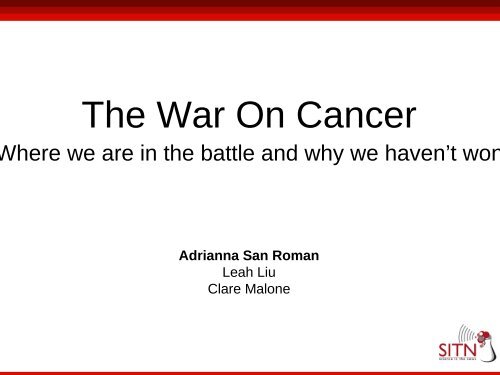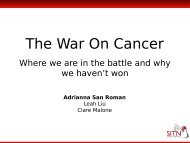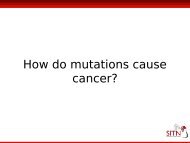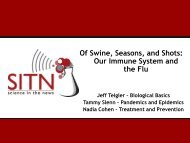The War On Cancer
The War On Cancer
The War On Cancer
Create successful ePaper yourself
Turn your PDF publications into a flip-book with our unique Google optimized e-Paper software.
<strong>The</strong> <strong>War</strong> <strong>On</strong> <strong>Cancer</strong><br />
here we are in the battle and why we haven’t won<br />
Adrianna San Roman<br />
Leah Liu<br />
Clare Malone
<strong>The</strong> <strong>War</strong> on <strong>Cancer</strong><br />
• 1971 Nixon’s State of the Union<br />
Address declared war on cancer<br />
• Since then, over $200 billion spent<br />
on research<br />
• Death rate from all cancers<br />
has decreased by 5%<br />
since 1950
“Advances Elusive in the<br />
Drive to Cure <strong>Cancer</strong>” –<br />
New York Times, April 23,<br />
2009<br />
Why haven’t we cured cancer<br />
yet?<br />
“Off Target in the <strong>War</strong><br />
on <strong>Cancer</strong>” –<br />
Washington Post,<br />
November 4, 2007
Outline<br />
• Lecture 1: Principles of cancer<br />
• Lecture 2: <strong>Cancer</strong> therapeutics<br />
• Lecture 3: Obstacles in developing<br />
cancer<br />
therapies
Objectives:<br />
Who is the enemy?<br />
• Define properties of cancer cells<br />
• Explain how DNA mutations and cell<br />
signaling pathways contribute to cancer<br />
• Recognize that cancer is not one<br />
disease
<strong>The</strong> Human Body is Made of<br />
Cells Organized into Tissues<br />
Cel<br />
l<br />
Intestine<br />
Cross-section<br />
of the intestine
<strong>The</strong> Human Body is Made of<br />
Cells Organized into Tissues<br />
Liver<br />
Muscle<br />
Stomac<br />
h<br />
Lungs &<br />
heart<br />
Intestine<br />
Kidneys
General Properties of <strong>Cancer</strong><br />
Cells<br />
1. Cell growth and division<br />
2. Cell movement
Unlimited and Uncontrolled<br />
Replication<br />
Normal<br />
Cell<br />
<strong>Cancer</strong><br />
Cell<br />
Tumo
<strong>Cancer</strong> Cells Avoid Cell<br />
Death<br />
Damage<br />
Normal<br />
Cell<br />
<strong>Cancer</strong><br />
Cell
<strong>Cancer</strong> Cells Ignore<br />
Signals<br />
• Self sufficient in growth signals<br />
• Insensitive to anti-growth signals<br />
Normal<br />
Cell<br />
Normal<br />
Cell<br />
X
<strong>Cancer</strong> Cells Ignore<br />
Signals<br />
• Self sufficient in growth signals<br />
• Insensitive to anti-growth signals<br />
<strong>Cancer</strong><br />
Cell
What does uncontrolled<br />
growth look like?<br />
Normal<br />
Intestine<br />
Adenoma<br />
(precursor to colon cancer)
General Properties of <strong>Cancer</strong><br />
Cells<br />
1. Cell growth and division<br />
• Unlimited, rapid growth and<br />
division<br />
• Avoids cell death<br />
• Does not respond to signals<br />
1. Cell movement
“Metastasis”<br />
<strong>Cancer</strong> Cells Can Leave <strong>The</strong>ir<br />
Home Tissue and Spread<br />
Throughout the Body<br />
Liver<br />
Muscle<br />
Stomac<br />
h<br />
Lungs &<br />
heart<br />
Intestine<br />
Kidneys
General Properties of <strong>Cancer</strong><br />
Cells<br />
1. Cell growth and division<br />
• Unlimited, rapid growth and<br />
division<br />
• Avoids cell death<br />
• Does not respond to signals<br />
1. Cell movement (metastasis)
What Makes <strong>Cancer</strong> Cells<br />
Have <strong>The</strong>se Abnormal<br />
Properties?<br />
• It starts with their DNA…
Genes and Proteins<br />
• DNA is located in the<br />
nucleus of the cell –<br />
“instruction manual”<br />
• DNA is divided into<br />
genes – “chapter”<br />
• Each gene makes one<br />
protein – “machine”
Mistakes or Damage to DNA<br />
Causes Mutations<br />
Inherited<br />
Mutated<br />
DNA<br />
UV Exposure<br />
Abnormal protein<br />
Smoking<br />
“Broken machine”
<strong>On</strong>cogenes and Tumor<br />
Suppressors<br />
• <strong>On</strong>cogenes are genes that can cause<br />
cancer, their encoded proteins have<br />
high activity in cancer.<br />
• Tumor suppressors are genes that work<br />
against cancer, their proteins have low<br />
activity in cancer.<br />
Normal<br />
Cell<br />
<strong>On</strong>cogen<br />
e<br />
Tumor<br />
suppressor<br />
Normal<br />
Cell
<strong>On</strong>cogenes and Tumor<br />
Normal<br />
Cell<br />
Suppressors<br />
• <strong>On</strong>cogenes are genes that can cause cancer,<br />
their encoded proteins have high activity in<br />
cancer.<br />
• Tumor suppressors are genes that work<br />
against cancer, their proteins have low<br />
activity in cancer.<br />
<strong>On</strong>cogen<br />
eTumor suppressor<br />
<strong>Cancer</strong><br />
Cell
Principle of <strong>Cancer</strong><br />
Driver<br />
mutation #1<br />
Progression<br />
Driver<br />
mutation #2<br />
Driver<br />
mutation #3<br />
Driver<br />
mutation #4<br />
Normal<br />
Other mutations<br />
<strong>Cancer</strong>
Driver vs. Passenger<br />
Mutations<br />
• “Driver” initiates the cancer<br />
process<br />
• “Passenger” is a mutation that<br />
happens along the way to<br />
becoming cancer
Principle of <strong>Cancer</strong><br />
Driver<br />
mutation #1<br />
Progression<br />
Driver<br />
mutation #2<br />
Driver<br />
mutation #3<br />
Driver<br />
mutation #4<br />
Passenger mutations<br />
Normal<br />
<strong>Cancer</strong>









